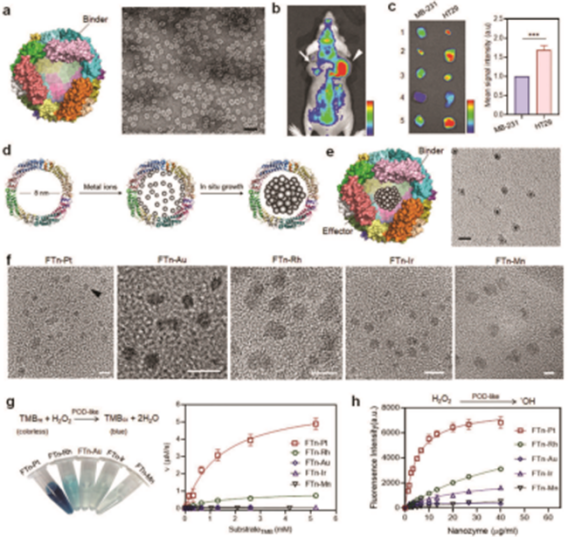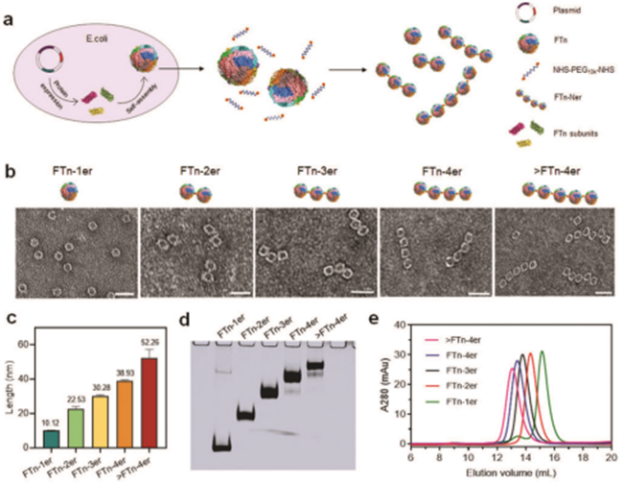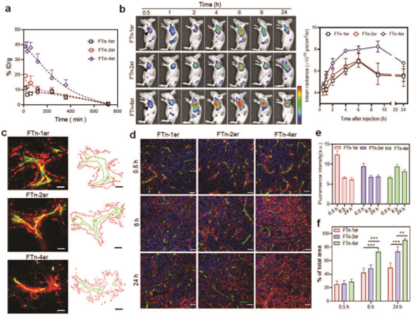When Synthetic Biology Technology Meets Nano-enzyme
Recently, Professor Huang Xinglu’s Team from College of Life Sciences, State Key Laboratory of Medicinal Chemical Biology and Front Cross Center of Cellular Response at Nankai University has integrated synthetic biology technology and nanotechnology, created a nano-enzyme material with tumor targeting and killing functions based on biosynthesis, and developed a new modular assembly poly nano-enzyme based on the “bottom-up” assembly strategy for tumor killing. The research results have been published online on Advanced Materials (Adv Mater. 2021 Aug 5:e2103128), and Liu Qiqi, a 2019 doctoral student from College of Life Sciences of Nankai University is the first author.
Using genetic engineering and protein expression technology, the researchers have developed a humanized recombinant heavy chain ferritin (FTn) with self-assembly characteristics, which has the characteristics of targeted tumors. Based on the internal cavity structure and metal affinity characteristics of the protein, various types of metal nanoparticles grew in situ. Through screening, nano-enzyme materials with high peroxidase-like activity was obtained, which can produce highly active free radicals and induce the signals of tumor cell death.

Figure 1: Characteristics of Biosynthetic Nano-enzyme.a) FTn SEM Photograph. b, c) Analysis of FTn Tumor-Targeting Characteristics. D) Diagram of Metal Particles Grown in situ in FTn Cavity. e) Diagram of FTn Nano-enzyme and SEM Photograph of Negative Staining.f) Nano-enzyme SEM Photograph of Different Metals Based on FTn. g) Peroxidase-like Activity Analysis of Different Metal Nano-enzymes. h) Ability of Nano-enzyme to Catalyze the Production of Hydroxyl Radicals.
It is still a prominent challenge to customize the required nano-materials based on the high control over morphology and binding domain. In the study, a modular assembly strategy based on humanized recombinant heavy chain ferritin is introduced to accurately and quantitatively customize high-order nanostructures. In the strategy, FTn is used as a protein building block, which is further re-assembled through two-arm PEG after being recombined and purified in Escherichia coli. Using the “bottom-up” layered modular assembly strategy for such protein building block, as well as metal load inside FTn, a series of new poly nano-enzymes have been produced.

Figure 2: a) Diagram of FTn Polymer Prepared by Two-step Self-assembly/Post-assembly Method. b-e) Representative TEM Image and Quantitative Analysis of Various Assembly Nano-structures.
The assembled nano-polymer has an adjustable protein base and a polyvalent binding domain. Such polyvalent assembly helps extend blood circulation time and can accumulate in tumor cells by directly targeting cell surface receptors and penetrate deeply into tumor tissues through transcytosis mechanism.

Figure 3: In Vivo Behavior of Different FTn Assemblies. a) Blood Circulation Time Curve of Different Assemblies after Intravenous Administration. b) Analysis of Tumor-Targeting Ability of Different Assemblies. c) Analysis of Vessel Penetration Ability. d-f) Analysis of Tumor Tissue Penetration Ability.
In the study, new nanotechnology is developed based on synthetic biology technology, nano-polymer assembled by humanized recombinant heavy chain ferritin is used as support, metal nanocluster is added in situ into the cavity of protein nanocage, and a series of new artificial enzymes have been created. Meanwhile, combined with the “bottom-up” modular assembly strategy, polyvalent nano-enzyme materials have been constructed to improve the tumor-targeting ability and therapeutic effect. The strategy also provides ideas for the exact design of biomedical nano-materials.
Link to the paper: https://onlinelibrary.wiley.com/doi/10.1002/adma.202103128









